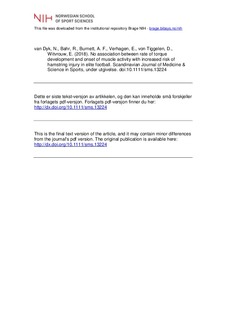| dc.contributor.author | van Dyk, Nicol | |
| dc.contributor.author | Bahr, Roald | |
| dc.contributor.author | Burnett, Angus F. | |
| dc.contributor.author | Verhagen, Evert | |
| dc.contributor.author | von Tiggelen, Damien | |
| dc.contributor.author | Witvrouw, Erik | |
| dc.date.accessioned | 2019-05-09T07:44:01Z | |
| dc.date.available | 2019-05-09T07:44:01Z | |
| dc.date.created | 2018-05-25T09:54:26Z | |
| dc.date.issued | 2018 | |
| dc.identifier.citation | Scandinavian Journal of Medicine & Science in Sports. 2018, 28, 2153-2163. | nb_NO |
| dc.identifier.issn | 0905-7188 | |
| dc.identifier.uri | http://hdl.handle.net/11250/2597051 | |
| dc.description | I Brage finner du siste tekst-versjon av artikkelen, og den kan inneholde ubetydelige forskjeller fra forlagets pdf-versjon. Forlagets pdf-versjon finner du på onlinelibrary.wiley.com / In Brage you'll find the final text version of the article, and it may contain insignificant differences from the journal's pdf version. The definitive version is available at onlinelibrary.wiley.com | nb_NO |
| dc.description.abstract | Introduction: Hamstring injuries remain a significant burden in sports that involve high speed running. In elite male football, hamstring injury has repeatedly been identified as the most common noncontact injury, representing 12% of all injuries. As the incidence remains high, investigations are aimed at better understanding how to improve prevention efforts. Intrinsic risk factors such as strength have been investigated extensively in a cohort of professional football players; however, other intrinsic measures of neuromuscular function have not been studied in this cohort. This study aims to investigate the association between timing of hamstring muscle activity onset and the rate of torque development during the early phase of isokinetic strength testing with risk of hamstring injury in professional football players in a prospective cohort study. Methods: All teams (n=18) eligible to compete in the premier football league in Qatar underwent a comprehensive strength assessment during their annual periodic health evaluation at Aspetar Orthopaedic and Sports Medicine Hospital in Doha, Qatar. Variables included rate of torque development and timing of muscle activity onset. Results: A total of 367 unique players (60.6% of all QSL players) competed for 514 player seasons (103 players competed both seasons) and sustained 65 hamstring injuries. There was no difference in the onset of muscle activity between the biceps femoris and medial hamstrings comparing the injured to uninjured players. For both onset of muscle activity and rate of torque development, there were no significant differences between any of the variables (p>0.05), with small effect sizes detected across all the different variables (d<0.3). Conclusion: Rate of torque development and onset of muscle activity were not associated with a risk of future hamstring injury. The use of these measures as part of a periodic health evaluation to identify risk of hamstring injury is unsupported. | nb_NO |
| dc.language.iso | eng | nb_NO |
| dc.subject | hamstrings | nb_NO |
| dc.subject | injury prevention | nb_NO |
| dc.subject | muscle injury | nb_NO |
| dc.subject | rate of torque development | nb_NO |
| dc.subject | risk factors | nb_NO |
| dc.title | No association between rate of torque development and onset of muscle activity with increased risk of hamstring injury in elite football | nb_NO |
| dc.type | Journal article | nb_NO |
| dc.type | Peer reviewed | nb_NO |
| dc.description.version | acceptedVersion | nb_NO |
| dc.source.pagenumber | 2153-2163 | nb_NO |
| dc.source.volume | 28 | nb_NO |
| dc.source.journal | Scandinavian Journal of Medicine & Science in Sports | nb_NO |
| dc.source.issue | 10 | nb_NO |
| dc.identifier.doi | 10.1111/sms.13224 | |
| dc.identifier.cristin | 1586658 | |
| dc.description.localcode | Seksjon for idrettsmedisinske fag / Department of Sports Medicine | nb_NO |
| cristin.unitcode | 150,34,0,0 | |
| cristin.unitname | Seksjon for idrettsmedisinske fag | |
| cristin.ispublished | true | |
| cristin.fulltext | postprint | |
| cristin.qualitycode | 2 | |
